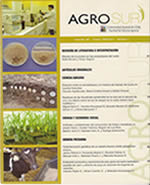Prediction of wool quality by Near Infrared Reflectance Spectroscopy (NIRS)
Main Article Content
Abstract
This study was performed to evaluate the potential of Near Infrared Spectroscopy (NIRS) to predict some economically relevant variables of sheep wool, such as average fiber diameter (DMF), traction resistance (RT), scouring percentage (RL), comfort factor (FC) and staple length (LM). Corriedale and Multi Purpose Merino (MPM) wool samples (22 of each genotype) were scanned with a NIRSystems 6500 monochromator. To obtain the reference data, samples were analyzed with an OFDA 2000 instrument (Consorcio Ovino S.A.) and using the Sirolan Laser scan technique (New Zealand Wool Testing Authority, NZWTA Laboratory). Regression equations (WINISI II software) were obtained for the spectral data and the different variables of wool quality, by using modified partial least squares (MPLS) applying different mathematical treatments to the spectral values. The best equations were selected based on the determination coefficient of cross validation (R2CV), the standard error of cross validation (SECV) and the relation RPD, i.e., between standard deviation of reference data and the SECV. Three out of the five wool variables (DMF, RL and FC) could be reliably predicted by the NIR spectra, with calibrations that achieved a RPD>3 (DMF and FC) or very close to 3 (RL). No reliable equations could be obtained for RT and LM. It is concluded that NIRS has the capability to predict some wool variables of economic relevance, such as fiber diameter, comfort factor and scouring percentage.

